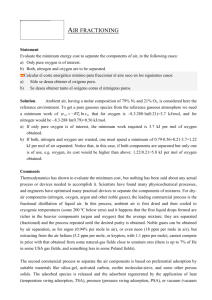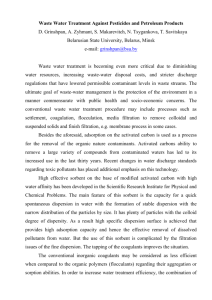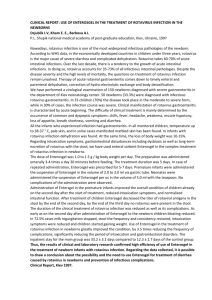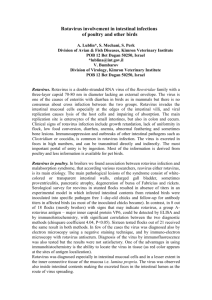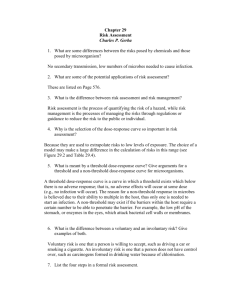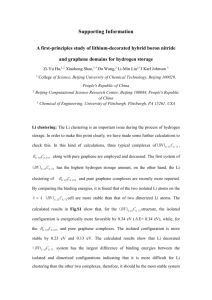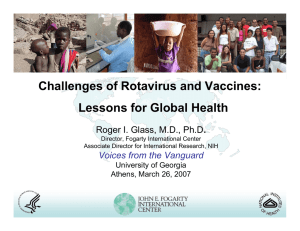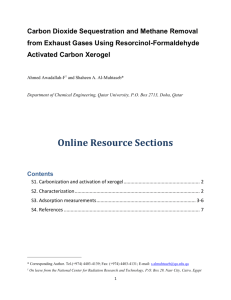liquid cu
advertisement
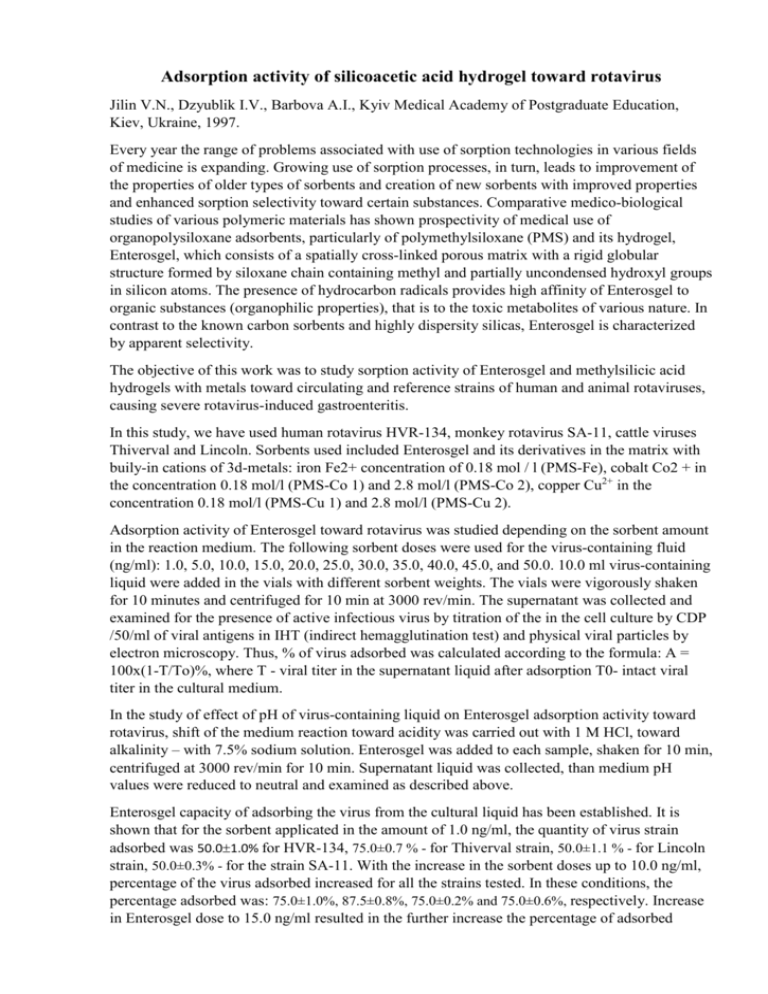
Adsorption activity of silicoacetic acid hydrogel toward rotavirus Jilin V.N., Dzyublik I.V., Barbova A.I., Kyiv Medical Academy of Postgraduate Education, Kiev, Ukraine, 1997. Every year the range of problems associated with use of sorption technologies in various fields of medicine is expanding. Growing use of sorption processes, in turn, leads to improvement of the properties of older types of sorbents and creation of new sorbents with improved properties and enhanced sorption selectivity toward certain substances. Comparative medico-biological studies of various polymeric materials has shown prospectivity of medical use of organopolysiloxane adsorbents, particularly of polymethylsiloxane (PMS) and its hydrogel, Enterosgel, which consists of a spatially cross-linked porous matrix with a rigid globular structure formed by siloxane chain containing methyl and partially uncondensed hydroxyl groups in silicon atoms. The presence of hydrocarbon radicals provides high affinity of Enterosgel to organic substances (organophilic properties), that is to the toxic metabolites of various nature. In contrast to the known carbon sorbents and highly dispersity silicas, Enterosgel is characterized by apparent selectivity. The objective of this work was to study sorption activity of Enterosgel and methylsilicic acid hydrogels with metals toward circulating and reference strains of human and animal rotaviruses, causing severe rotavirus-induced gastroenteritis. In this study, we have used human rotavirus HVR-134, monkey rotavirus SA-11, cattle viruses Thiverval and Lincoln. Sorbents used included Enterosgel and its derivatives in the matrix with buily-in cations of 3d-metals: iron Fe2+ concentration of 0.18 mol / l (PMS-Fe), cobalt Co2 + in the concentration 0.18 mol/l (PMS-Co 1) and 2.8 mol/l (PMS-Co 2), copper Cu2+ in the concentration 0.18 mol/l (PMS-Cu 1) and 2.8 mol/l (PMS-Cu 2). Adsorption activity of Enterosgel toward rotavirus was studied depending on the sorbent amount in the reaction medium. The following sorbent doses were used for the virus-containing fluid (ng/ml): 1.0, 5.0, 10.0, 15.0, 20.0, 25.0, 30.0, 35.0, 40.0, 45.0, and 50.0. 10.0 ml virus-containing liquid were added in the vials with different sorbent weights. The vials were vigorously shaken for 10 minutes and centrifuged for 10 min at 3000 rev/min. The supernatant was collected and examined for the presence of active infectious virus by titration of the in the cell culture by CDP /50/ml of viral antigens in IHT (indirect hemagglutination test) and physical viral particles by electron microscopy. Thus, % of virus adsorbed was calculated according to the formula: A = 100x(1-T/To)%, where T - viral titer in the supernatant liquid after adsorption T0- intact viral titer in the cultural medium. In the study of effect of pH of virus-containing liquid on Enterosgel adsorption activity toward rotavirus, shift of the medium reaction toward acidity was carried out with 1 M HCl, toward alkalinity – with 7.5% sodium solution. Enterosgel was added to each sample, shaken for 10 min, centrifuged at 3000 rev/min for 10 min. Supernatant liquid was collected, than medium pH values were reduced to neutral and examined as described above. Enterosgel capacity of adsorbing the virus from the cultural liquid has been established. It is shown that for the sorbent applicated in the amount of 1.0 ng/ml, the quantity of virus strain adsorbed was 50.01.0% for HVR-134, 75.0±0.7 % - for Thiverval strain, 50.0±1.1 % - for Lincoln strain, 50.0±0.3% - for the strain SA-11. With the increase in the sorbent doses up to 10.0 ng/ml, percentage of the virus adsorbed increased for all the strains tested. In these conditions, the percentage adsorbed was: 75.0±1.0%, 87.5±0.8%, 75.0±0.2% and 75.0±0.6%, respectively. Increase in Enterosgel dose to 15.0 ng/ml resulted in the further increase the percentage of adsorbed rotavirus: 93.8±0.2% - Thiverval and SA-11 strains and 87,5±0,4% - for HRV-134 and Lincoln strains. Further increase of the sorbent dose in the virus-containing medium did not cause any change in the values already achieved. Study of Enterosgel adsorption activity toward viruses at different pH levels was of great interest. It was established that the maximum percentage of adsorbed virus SA-11 (98.4±0.2%) recorded at pH 6.5-7.0. For rotavirus Thiverval strain, the maximum (96.9±0.3%) was at pH 5.0. For Lincoln strain, adsorption performance was higher (93.8±0.3%) at pH 4.5. Maximum adsorption of human rotavirus from all samples (87.5±0.5%) occurred at pH 6.5-8.0. Adsorptive activity of hydrogels with metal cations towards rotavirus was studied placing them into the reaction medium in optimal doses of 15-30 ng/ml at the optimum pH 6.5-7.5. Studies showed that at pH 6.5 all the drugs efficiently adsorbed human viruses, while PMS-Co 1 (98.4±0.1%), PMS-Co 2, PMS-Cu 2 (96.9±0.3%), PMS-Cu 1 (93.8±0.3% ) dominated. An exception was ICP-Fe containing iron cations: the percentage of rotavirus adsorbed was 50.0±0.5%, which is almost twice less than that of Enterosgel (98.4±0.2%, p<0,01). At pH 7.0, MPS-Co 1 was the most efficient in terms of human rotavirus sorption (96.9±0.3%). The least effective in human rotavirus adsorption was PMS-Cu 1 (87.5±0.5%). Insertion of MPS-Fe, MPS-Co 2 and PMS-Cu 2 had no effect on the increase in the rotavirus adsorption. pH shift towards alkalinity (pH 7.5) created such conditions for the virus-sorbent interaction, in which the percentage of virus adsorbed by PMS-Fe, PMS-Co 1 and PMS-Co 2 was 96.9±0.3%. Copper-containing drugs PMS-Cu 1 and 2 sorbed rotavirus significantly weaker (87.5±0.6%), p<0.5. Thus, studies have shown the ability of Enterosgel and its derivatives with 3d-metal cations to adsorb rotaviruses from virus-cintaining fluid that offers great opportunities to use them for the laboratory diagnosis and treatment of rotavirus-induced diarrhea. Clinical report. Kyiv, Ukraine, 1997
